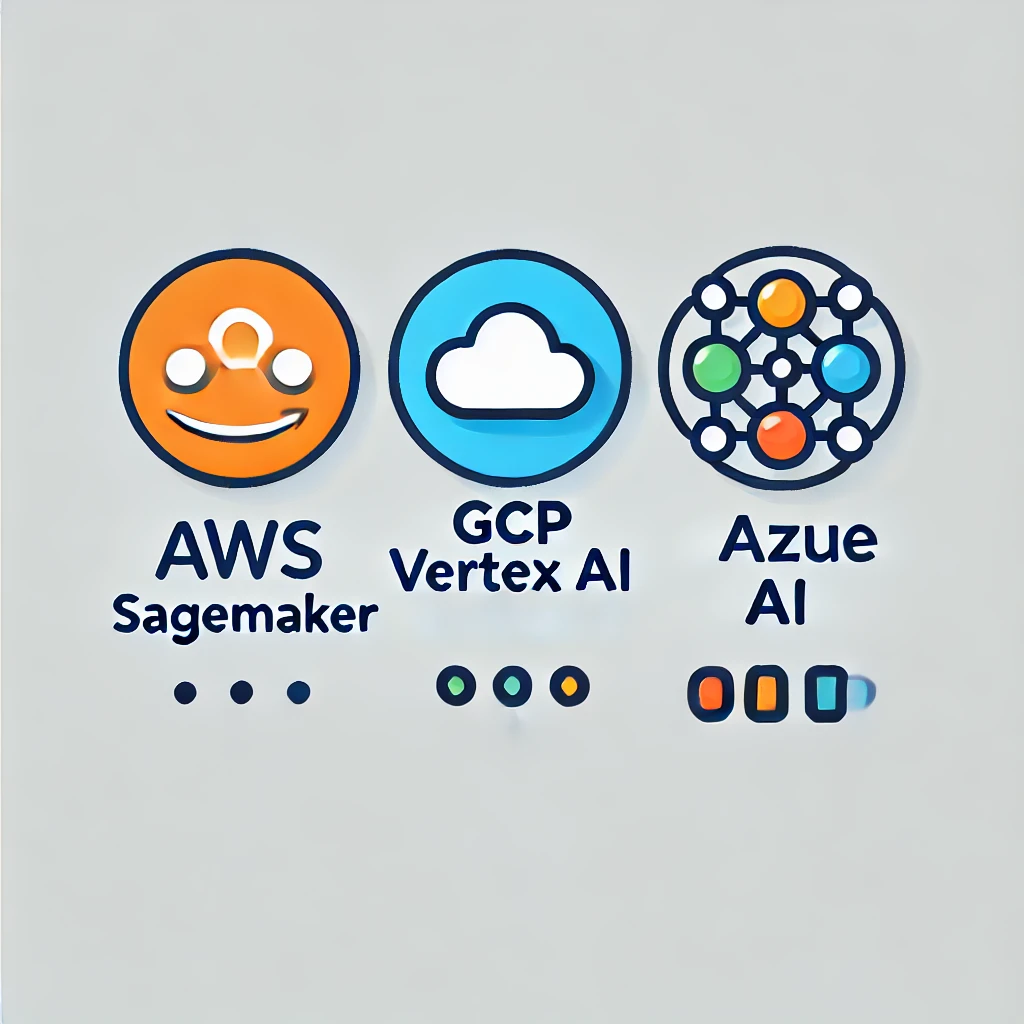The Rise of Cloud-Based AI
Introduction: Unveiling the AI Titans :-
- The world of artificial intelligence is rapidly evolving, and cloud computing has become the backbone of many AI initiatives. This means companies big and small are leveraging cloud services to power their AI projects, making the choice of the right platform crucial. Among the major players in cloud-based AI, AWS SageMaker, GCP Vertex AI, and Azure AI stand out, each offering a unique set of features and capabilities. This article will delve into a detailed comparison, examining their strengths, weaknesses, and overall suitability for various applications.
The Rise of Cloud-Based AI :-
- Cloud-based AI platforms have revolutionized the way businesses approach artificial intelligence. Access to powerful computing resources, scalable infrastructure, and pre-trained models has reduced the barriers to entry significantly. This makes AI more accessible to organizations of all sizes, driving innovation across various sectors. The convenience of cloud services has also fostered rapid development and deployment of AI solutions.
Why Compare AWS SageMaker, GCP Vertex AI, and Azure AI?
- With multiple competitive cloud platforms offering AI services, choosing the right platform can be overwhelming. This comparison provides a clear understanding of each platform's unique features, advantages, and limitations. The goal is to empower readers with the knowledge needed to make informed decisions based on their specific requirements and project goals. A clear understanding of the strengths and weaknesses of each platform is essential for effective AI implementation.
- AI Prompt: A comparison table showcasing AWS SageMaker, GCP Vertex AI, and Azure AI, highlighting their key features, pricing, scalability, ease of use, and integration capabilities.
AWS SageMaker: Amazon's AI Powerhouse :-
- AWS SageMaker is a fully managed service that empowers developers and data scientists to build, train, and deploy machine learning models at scale. Its comprehensive suite of tools and features makes it a popular choice for many organizations. SageMaker offers a seamless experience, from data preparation to model deployment, all within a single platform.
Core Features and Capabilities :-
- SageMaker offers a plethora of features, including built-in algorithms, support for various programming languages (Python, R, etc.), automated model tuning, and robust monitoring capabilities. It also integrates well with other AWS services, such as S3 for data storage and EC2 for compute resources. The platform provides a collaborative environment for teams to work on projects efficiently, enhancing productivity and reducing development time.
Strengths and Use Cases :-
- SageMaker's scalability is a major advantage, allowing businesses to handle large datasets and complex models with ease. Its broad range of algorithms and pre-trained models also simplifies the development process, enabling faster time-to-market for AI solutions. Common use cases include image recognition, natural language processing, fraud detection, and predictive maintenance.
Limitations and Considerations :-
- While SageMaker is powerful, it can be complex for beginners to navigate. Understanding the nuances of the various services and features requires some experience with AWS and machine learning. Cost can also be a factor, as scaling up resources for large projects can quickly become expensive. Careful planning and resource optimization are crucial to minimize costs.
GCP Vertex AI: Google's AI Platform :-
- GCP Vertex AI is Google Cloud's unified machine learning platform, bringing together various AI services into a single, cohesive environment. Its integration with other Google Cloud services, such as BigQuery and Dataflow, streamlines the data processing and model development workflow. Vertex AI caters to a wide range of users, from beginners to experienced machine learning professionals.
Key Features and Functionality :-
- Vertex AI boasts powerful tools for model building, training, and deployment. It includes AutoML, which simplifies the development process for users with limited machine learning expertise. Its integration with Google's powerful AI models provides access to state-of-the-art capabilities. Vertex AI also supports various programming languages and frameworks, offering flexibility for different development styles.
Advantages and Applications :-
- One of Vertex AI's major strengths is its ease of use, especially for beginners. AutoML dramatically simplifies the model development process, eliminating the need for extensive coding and machine learning knowledge. This makes AI development more accessible to a broader audience. Vertex AI finds applications in diverse fields, including healthcare, finance, retail, and manufacturing.
Shortcomings and Challenges :-
- While Vertex AI is user-friendly, its extensive features can sometimes be overwhelming. Navigating the platform and selecting the appropriate tools and services requires some understanding of Google Cloud's ecosystem. Cost can also become significant, particularly when dealing with large datasets and complex models requiring significant compute resources.
Azure AI: Microsoft's Comprehensive Suite :-
- Azure AI offers a comprehensive suite of AI services, ranging from pre-trained models to custom model development tools. Its integration with other Azure services, such as Azure Blob Storage and Azure SQL Database, creates a smooth workflow for managing data and deploying AI solutions. Microsoft's strong emphasis on enterprise-grade features makes Azure AI suitable for large-scale deployments.
Core Components and Services :-
- Azure AI comprises various components, including Azure Machine Learning, Azure Cognitive Services, and Azure Bot Service. Each component serves a specific purpose, providing developers with the tools they need to build various types of AI solutions. Microsoft's investment in open-source technologies makes Azure AI compatible with many popular frameworks and libraries.
Benefits and Practical Applications :-
- Azure AI's broad range of services caters to a diverse set of needs, from simple AI integration to complex custom model development. Its strong enterprise-grade features, security measures, and scalability make it ideal for large organizations with stringent requirements. Azure AI's versatility makes it applicable across various industries and use cases.
Drawbacks and Potential Issues :-
- While Azure AI offers a wide array of services, the complexity can be overwhelming for newcomers. Understanding the various services and choosing the right ones for a given project can require significant upfront effort. The pricing model can also be complex, and managing costs effectively requires careful planning and resource allocation.
Comparative Analysis: A Head-to-Head Showdown :-
- Now, let's compare AWS SageMaker, GCP Vertex AI, and Azure AI across several key aspects to aid you in selecting the most suitable platform for your specific needs.
Pricing Models and Cost Optimization :-
- Each platform uses a pay-as-you-go model, but pricing structures vary. Factors like compute time, storage, and data transfer influence the final cost. Careful resource management and optimization techniques are crucial to minimize expenses. Understanding the pricing nuances of each platform is crucial for effective budget planning.
Ease of Use and Developer Experience :-
- GCP Vertex AI generally scores higher on ease of use, especially for beginners, thanks to its AutoML features. SageMaker and Azure AI, while powerful, require more technical expertise to fully utilize their advanced functionalities. Choosing a platform depends on the technical skills of your development team.
Scalability and Performance :-
- All three platforms offer excellent scalability and performance. However, the optimal choice depends on the size and complexity of your AI projects. For extremely large-scale projects, the infrastructure capacity and performance characteristics of each platform should be carefully evaluated.
Integration with Other Cloud Services :-
- Seamless integration with other services within each cloud ecosystem is a key advantage. SageMaker integrates well with other AWS services, Vertex AI with GCP services, and Azure AI with Azure services. This integration streamlines workflows and reduces development complexities.
Community Support and Resources :-
- Each platform has a sizable community offering support and resources. However, the specific quality and extent of support might vary. Consider the availability of documentation, tutorials, and community forums when making your decision.
Choosing the Right AI Service: Key Decision Factors :-
- Selecting the ideal AI platform requires careful consideration of several factors.
Understanding Your AI Needs :-
- Clearly define your AI project requirements, including the type of AI model, data size, desired performance, and budget constraints. This clear definition will guide you towards the best-suited platform. Consider whether you need pre-trained models or require custom model development.
Evaluating Your Existing Infrastructure :-
- Assess your current IT infrastructure and its compatibility with each platform. If you already use AWS, GCP, or Azure for other services, choosing the platform that seamlessly integrates with your existing infrastructure could simplify management and reduce costs.
Considering Future Scalability :-
- Consider the potential for future growth and scalability. Choose a platform capable of handling increased data volumes and computational demands as your AI project evolves. Scalability is crucial for long-term success and adaptability.
Budgetary Constraints and Cost Analysis :-
- Develop a comprehensive cost analysis based on your project needs and the pricing models of each platform. Compare the total cost of ownership, including compute costs, storage costs, and other relevant expenses. Budget constraints often play a significant role in the final decision.
Conclusion: The Future of Cloud-Based AI :-
- The rapid advancements in cloud-based AI services continue to reshape how businesses approach AI development and deployment. AWS SageMaker, GCP Vertex AI, and Azure AI each offer unique strengths and cater to diverse needs. By carefully considering your specific requirements and evaluating the factors discussed in this article, you can select the platform best suited for your AI journey. The future of AI is undoubtedly bright, and these cloud platforms are at the forefront of this exciting evolution.
Review
Kalpesh Shewale
I am grateful to have completed my Full Stack Development with AI course at Apnaguru. The faculty's support and interactive classes helped me discover my potential and shape a positive future. Their guidance led to my successful placement, and I highly recommend this institute.
Kalpesh Shewale
I am grateful to have completed the Full Stack Development with AI course at Apnaguru. The faculty's dedicated support and hands-on approach during the classes enabled me to unlock my potential and shape a promising future. Their guidance helped me secure a placement with a good package. I highly recommend this course, and for those interested, I also suggest doing the offline version at the center for an enhanced learning experience.

Raveesh Rajput
Completing the Full Stack Development with AI course at Apnaguru was a game-changer for me. I secured an internship through this course, which gave me invaluable hands-on experience. I strongly recommend this course to anyone looking to break into the tech industry. For the best experience, I suggest attending the offline sessions at the center, where the interactive learning environment really enhances the overall experience.

swapnil shinde
Apnaguru’s Full Stack Development with AI course provided me with more than just knowledge—it opened doors to an internship that gave me real-world, hands-on experience. If you're serious about a career in tech, this course is a must. I highly recommend attending the offline sessions for the most immersive and interactive learning experience!
Kalpana Waghmare
I recently completed the Full Stack Developer with AI course on ApnaGuru, and I couldn’t be more impressed! The structure of the course, with well-organized topics and self-assessment MCQs after each section, really helped reinforce my learning. The assignments were particularly valuable, allowing me to apply what I learned in a practical way. Overall, it’s an excellent program that effectively combines full-stack development and AI concepts. Highly recommended for anyone looking to enhance their skills!
Completing the Full Stack Development with AI course at Apnaguru was a pivotal moment in my career. It not only deepened my understanding of cutting-edge technologies but also directly led to an internship that provided practical, real-world experience. If you're aiming to enter the tech field, this course is an excellent stepping stone. I especially recommend attending the in-person sessions at the center, where the dynamic, hands-on learning approach truly maximizes the benefits of the program.

Mahesh Bhosle
I completed the Full Stack Development course at Apnaguru, and it was a valuable experience. The focus on live assignments and projects gave me real-world insights, helping me apply my skills in a professional setting. The interactive live sessions, mock interviews, and question banks were excellent for job preparation. Apnaguru’s company-like environment also helped me get accustomed to real work dynamics. Overall, this course equipped me with the skills and confidence needed for a career in full-stack development. I highly recommend it to anyone seeking hands-on learning and industry relevance.
I recently completed the Full Stack course at ApnaGuru, and I’m genuinely impressed! The curriculum is well-structured, covering both front-end and back-end technologies comprehensively. The instructors are knowledgeable and provide hands-on experience through practical projects. The supportive community and resources available made learning enjoyable and engaging. Overall, it’s a great choice for anyone looking to kickstart a career in web development. Highly recommend!

Adarsh Ovhal
I recently participated in the Full Stack Development With AI Course program, and it has been incredibly beneficial. The guidance I received was tailored to my individual needs, thanks to their advanced use of AI tools. The Trainers were knowledgeable and supportive, helping me explore various educational and career paths. The resources and workshops provided were practical and insightful, making my decision-making process much clearer. Overall, I highly recommend this program to any student looking for IT Field and personalized career guidance!
Shirish Panchal
I’m currently pursuing the Full Stack Developer with AI course at ApnaGuru Training Center, and I'm impressed with what I've experienced so far. The curriculum is well-structured, covering key concepts in both front-end and back-end development, along with AI fundamentals. The instructors are knowledgeable and supportive, which makes it easy to engage and ask questions. I particularly appreciate the hands-on projects that help reinforce what I’m learning. While I’m still in the process of completing the course, I feel that I'm building a strong foundation for my future in tech. I would recommend ApnaGuru to anyone looking to explore full stack development with AI!
Apnaguru Training Center stands out as a top-notch institute for IT education. They provide a wide array of courses, including Full Stack Development, Java Full Stack, Python, Automation Testing, DevOps, and MERN/MEAN Stack, all designed to meet the demands of the modern tech industry.

Mahesh Bhosle
Apnaguru Training Center is a fantastic place for IT education! They offer a variety of courses, including Full Stack Development, Java Full Stack, and Python, all taught by knowledgeable instructors who are committed to student success. The curriculum is up-to-date and includes hands-on projects that enhance learning.
dandewar srikanth
I had an excellent experience with the full-stack web development program at APNAGURU. The instructor had in-depth knowledge of both frontend and backend technologies, which made the concepts easy to grasp. From working on HTML, CSS, JavaScript, and React for the frontend to Node.js and MongoDB for the backend, the learning curve was very smooth.
